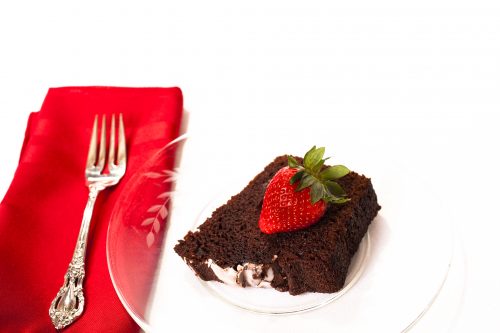
With these makeovers, you can indulge with less guilt.
Chocolate, chocolate and more chocolate
Chocolate, in many forms, looms large as many people’s favourite comforting food. Here are some healthier versions of chocolate treats:
HFG chocolate self-saucing pudding
HFG chocolate brownie
HFG chocolate chip biscuits with apricots and nuts
How they compare
Traditional chocolate brownie
Total energy per serve = 1315kJ
Total fat per serve = 18.3g (9.8g saturated fat)
HFG chocolate brownie
Total energy per serve = 530kJ
Total fat per serve = 5.0g (1.0g saturated fat)
Traditional chocolate chip biscuits
Total energy per serve = 615kJ
Total fat per serve = 7.7g (4.9g saturated fat)
HFG chocolate chip biscuits
Total energy per serve = 510kJ
Total fat per serve = 7.0g (1.6g saturated fat)
Ice cream
A premium vanilla ice cream can be up to 14% fat and 23% sugars, and a half cup serve will range from 600-900kJ. Fancy a more decadent variety? You could get as high as 20% fat, 28% sugars and a whopping 1600kJ in your 1/2 cup serve. So for a weekly treat we recommend lower-energy desserts.
If you want ice cream, choose a low-fat version (around 2% fat). Some also use alternative sweeteners so are low-sugar as well, which makes them even lower in energy (kJ). Sorbets are a good low-fat choice: they are high in sugar but overall have lower kilojoules. Frozen yoghurts have sugar added – it’s not just your standard yoghurt, frozen – but they tend to be low-fat and comparable in kilojoules to the low-fat ice creams. For most of these you’re still talking 400-500kJ for the 1/2 cup serve: they’re lower-energy, not no-energy treats.
The bottom line
Choose low-fat ice cream: you won’t notice the difference. Sorbet and frozen yoghurt are also good alternatives. There are lots of different products out there, so start label reading and
learn to savour small portions.
Cheesecake
A favourite dessert, which can be made less decadent – fat and sugar-wise – but just as tasty. Try our Passionfruit baked cheesecake recipe.
How they compare
Traditional cheesecake
Total energy per serve = 1910kJ
Total fat per serve = 32g (20g saturated fat)
HFG baked cheesecake
Total energy per serve = 870kJ
Total fat per serve = 11g (4g saturated fat)
Whipped cream
Cream will always be cream and the advice will always be to keep it to an occasional treat.
When you do, try this great trick to make it lighter and, we think, even tastier: add low-fat vanilla yoghurt to your cream, once it’s whipped, and mix through lightly. It’ll be sweet, creamy and slightly tangy, and you’ll save some fat and energy (just make sure you don’t use twice as much!).
Note: 1 cup of standard cream = 4000kJ, 100g fat (62g saturated).
Bread and butter pudding
- Leave out the butter: Bread and butter puddings originated as a way of using up buttered bread that was left over from a meal. The butter has no functional use in the recipe so can be easily left out.
- Add fruit: This adds flavour and texture as well as increasing the nutrient value of the dish. Apples, pears, bananas and dried fruit all work well.
- Add nuts: These also add texture and additional nutrients.
- Use fruit bread instead of plain bread: The spices and dried fruit in fruit bread add a new dimension to this dessert. Italian panetone can be used in a similar way. Do not use brioche or croissants, however, as they are both rich in butter and not good for heart health.
- Leave out cream: When a recipe calls for cream, replace it with trim milk or light evaporated milk. Cream is not necessary for a successful bread pudding and your heart and waistline will be better off without it.
www.healthyfood.com










